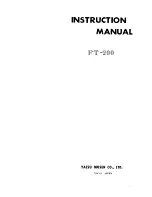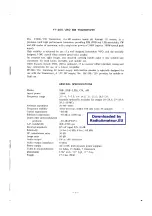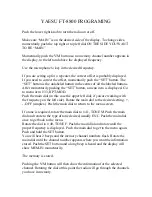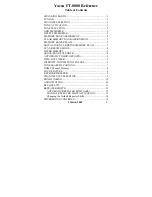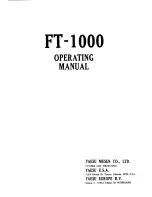
By Walter Cates WD0GOF (UPDATE 10/30/2013)
31
SUBSYSTEM TECHNICAL INFORMATION CONTINUED
3-6. PA LOADING COIL L32
I became a victim of a long time, incorrect assumption. When I first started working on the SR series I was told
that the plate coil of the SR-150 was a weak element that it could be damaged by too much power or mismatch
on 15 and 10 meters. I thought "oh well" and accepted it and even helped the myth along. I have found many of
these coils deformed and melted and either repaired or replaced the coil and went about my business. While
working on a 150 with exceptional power out on 15 and 10 meters I thought it was time to look seriously into
the problem. Not having had any real problems in the output ckt of the SR-150 in the past I have not paid it any
close attention. When I looked at the circuit and the components I was a little surprised. The end of the coil that
melts is actually shorted out on 40, 20, 15 and 10 meters and is only used on 80.
So I got out my IR thermometer and did some testing. There are only two ways I can get that end of the
coil to heat up. First, heating occurred if I induced a higher than 1.8:1 vswr on 80 meters. There was no
abnormal heating on the other bands until I reached 2.5:1 vswr. Second, heating occurred if I detuned the
neutralization and tuned for peak power and not the plate current dip on 80 meters. The coil heats a little on all
the bands with miss-match or improper plate dip. However, on 80 the tightly wound end gets hot and right now.
On the high frequency bands that end of the coil is the coolest end and it seems to be a heat sink, perhaps even
dumping some of the heat from the other end.
Just to be thorough I tested the shorted portions of the coil on each band for any stray resonance. I performed a
series of tests using the grid dip meter, sweep generator and spectrum analyzer on the coil cold and under power.
I looked at the spectrum for spurs under various conditions of mistuning and found nothing unusual.
So I think this myth is busted. But what has become very clear is, you must keep vswr low and tune the
plate to the current dip. This is critically important on the 80 meter band.
The critical nature of the VSWR and plate current dip applies to the entire SR series HF transceivers.
The coils of the rest of the series are much more robust, with the possible exception of the SR-2000 (but then
the 2000 is in a class of its own). Damage to coils for the rest of the SR series under normal operating
conditions is rare. HOWEVER, VSWR and plate current dip are extremely important to the
life of the P.A.
tubes
. In addition an improperly tuned P.A. will generate
splatter, harmonics
and an overall mushy sounding
transmitter.
The coil can sometimes be repaired using a heat gun. Slowly heat up the plastic and with a knife spread the
coils. NOTE: These assumptions are based on data derived from a series of tests performed on only one SR150.
Summary of Contents for SR-150
Page 18: ...By Walter Cates WD0GOF UPDATE 10 30 2013 18...
Page 19: ...By Walter Cates WD0GOF UPDATE 10 30 2013 19 BEFORE CLEANING CLEAN CHASSIS...
Page 20: ...By Walter Cates WD0GOF UPDATE 10 30 2013 20 3 1 2 TUBE SOCKET CLEANING KIT...
Page 21: ...By Walter Cates WD0GOF UPDATE 10 30 2013 21 3 1 3 AIR VARIABLE CLEANING...
Page 30: ...By Walter Cates WD0GOF UPDATE 10 30 2013 30 3 5 5 K3 WIRING AND PIN OUT...
Page 38: ...By Walter Cates WD0GOF UPDATE 10 30 2013 38 4 DATA SHEETS...































